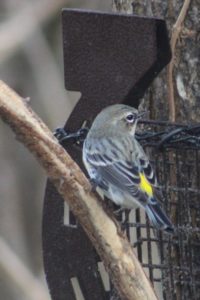By Bernheim

“What’s in a name? That which we call a rose / by any other name would smell as sweet”. Shakespeare may have been correct about the fragrance; however, over the years I’ve learned there is a great deal that goes into a name. Most often a name is the first piece of information we learn about a thing and, as we delve into these names, we become more closely connected with it. So it is with birds. From technical to colloquial, names have meaning. Most birds are given multiple names and each of them can tell us a little something about the bird.
All birds have a technical, scientific name. This is their taxonomic name and is generally made up of two parts. The first part tells us the genus; the second part gives us the species. A subspecies adds a third part. The root meaning of many of these names can be found in Latin. Others have been made into Latin for the sake of scientific consistency. All of them can teach us something about the bird in question.
For example, in our area we have several birds that are commonly referred to as ‘hawks’. When comparing taxonomic names we see some interesting differences and we begin learning more about them. The Coopers Hawk is Accipiter cooperii and the Sharp-shinned Hawk is Accipiter striatus. Accipiter comes from the Latin word accipu, meaning ‘to grasp or grab’. This strikes me as an appropriate name for a bird that hunts other birds, often grabbing its prey in flight. On the other hand, we have the Red-tailed Hawk and the Broad-winged Hawk. These two are named Buteo jamaicensis, and Buteo platypterus, respectively. Buteo means buzzard and refers more to their blocky physique than anything else. Jamaicensis is the Latinized form of Jamaica. Perhaps that is where the Red-tailed Hawk was first seen or described. I’m still searching for the answer. Platypterus is a joining of two Latin words that are much easier to decipher. Platy means wide, and pterus means winged. I will likely never learn enough Latin to understand all the taxonomic names. That’s okay. In this case the taxonomic name matches closely with the common name. I’ll take it.
Common names are the ones most of us are familiar with. These are the names we find in our field guides. As with the scientific names, common names are derived from a wide variety of things. They can describe a particularly striking feature such as that found on a Red-headed Woodpecker or a Tufted Titmouse. The name may describe where you are most likely to encounter them; think of a Field Sparrow or Barn Swallow. Sometimes it is a behavior that catches our attention like a Brown Creeper working its way around a tree or the frenzied tossing of leaves that are the trademark of a Brown Thrasher. In many cases birds will tell us their name if we listen. The Phoebe and Pewee are both pretty insistent, and who would ever think of calling a Whip-poor-will by any other name after listening to one all night. Baltimore Orioles got their name because the orange and black reminded people of the house colors of Lord Baltimore in England. Our official state bird, the Northern Cardinal, was so named because the deep red color was reminiscent of the robes worn by a Catholic Cardinal. Names can be inspired by almost anything. Behavior, sounds, colors, and places are all used in the naming of birds.

My favorite names have always been the ‘Colloquial’ names we give birds. These nicknames often say as much about us and our perceptions as they do about the bird. I think they provide us with the best stories as well. I love referring to an American Woodcock as a ‘Timberdoodle’, but in some places it is called a ‘Labrador Twister’. If you have ever witnessed one during its courtship display you understand the names. A Loggerhead Shrike is commonly called a ‘Butcher Bird’ or ‘Nine Killer’ due in no small part to its hunting and dining habits. Birders everywhere will affectionately call Yellow-rumped Warblers ‘Butter Butts’. I’m sure you can guess why. ‘Shy Poke’ is often used in reference to a variety of Herons. Apparently this has to do with the messy trails they leave behind when startled. I recently learned that American Goldfinches are called ‘Beet Birds’ or ‘Salad Birds’. It seems they enjoy snacking on garden greens in addition to their regular diet of seeds.
“What’s in a name”? Everything you can imagine and then some. I may never learn all the names there are to learn. I might never find the why that hides behind ‘Johnny Crane’. Each one I do learn, however, helps me connect on a deeper more personal level with the world around me.
If you know a good bird name or a story behind a name leave a comment, or better yet, pay us a visit at Bernheim Forest and share it with us. You can never have too many stories.
-Jim Scout, Volunteer Naturalist

